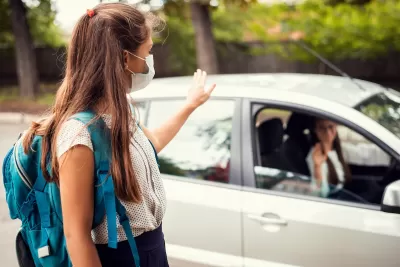School drop-off lines are becoming longer and more isolating than ever.

With more parents than ever before driving their children to school, school drop-offs are becoming a growing pain point for traffic in cities around the country, writes Kendra Hurley in The Atlantic.
The problem is multi-faceted: “For families, the long waits are at best a stressful time suck and at worst a work disruptor. Some city planners take the car line as proof of our failure to create the kind of people-centered neighborhoods families thrive in. Climate scientists might consider it a nitrogen-oxide-drenched environmental disaster. Scolds might rail at what they see as helicopter parents chaperoning their kids everywhere. Some pediatricians might point out the health threats: sedentary children breathing fumes or at risk of being hit by a car.”
For Hurley, another important aspect of the ever-growing school drop-off line is the attendant isolation. “With so many kids now attending schools more than a mile from their home, even the most beautiful, pedestrian-friendly streets may not be enough to lure passengers to the sidewalk. A leisurely stroll to a neighborhood school has been supplanted by the smelly, alienating car line.”
Hurley acknowledges that walking, biking, or public transit are not readily available modes for many American students. “But governments, schools, and communities can create new programs to fill the transportation gap” by proactively arranging walking and biking groups and urging local officials to add better bike and pedestrian infrastructure to their streets. “For families that must drive, the humble carpool can offer the same convenience and safety from crime as driving on your own, while also building camaraderie and minimizing emissions.”
FULL STORY: How School Drop-Off Became a Nightmare

Planetizen Federal Action Tracker
A weekly monitor of how Trump’s orders and actions are impacting planners and planning in America.

Congressman Proposes Bill to Rename DC Metro “Trump Train”
The Make Autorail Great Again Act would withhold federal funding to the system until the Washington Metropolitan Area Transit Authority (WMATA), rebrands as the Washington Metropolitan Authority for Greater Access (WMAGA).

The Simple Legislative Tool Transforming Vacant Downtowns
In California, Michigan and Georgia, an easy win is bringing dollars — and delight — back to city centers.

The States Losing Rural Delivery Rooms at an Alarming Pace
In some states, as few as 9% of rural hospitals still deliver babies. As a result, rising pre-term births, no adequate pre-term care and harrowing close calls are a growing reality.

The Small South Asian Republic Going all in on EVs
Thanks to one simple policy change less than five years ago, 65% of new cars in this Himalayan country are now electric.

DC Backpedals on Bike Lane Protection, Swaps Barriers for Paint
Citing aesthetic concerns, the city is removing the concrete barriers and flexposts that once separated Arizona Avenue cyclists from motor vehicles.
Urban Design for Planners 1: Software Tools
This six-course series explores essential urban design concepts using open source software and equips planners with the tools they need to participate fully in the urban design process.
Planning for Universal Design
Learn the tools for implementing Universal Design in planning regulations.
Smith Gee Studio
City of Charlotte
City of Camden Redevelopment Agency
City of Astoria
Transportation Research & Education Center (TREC) at Portland State University
US High Speed Rail Association
City of Camden Redevelopment Agency
Municipality of Princeton (NJ)





























